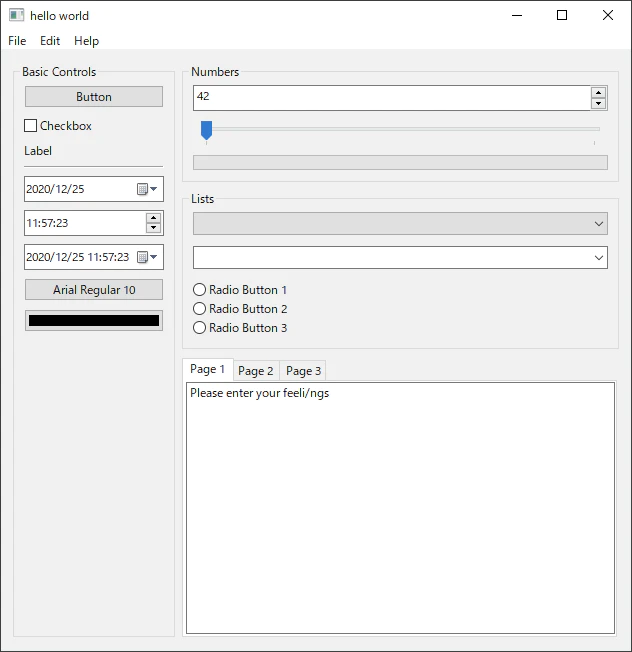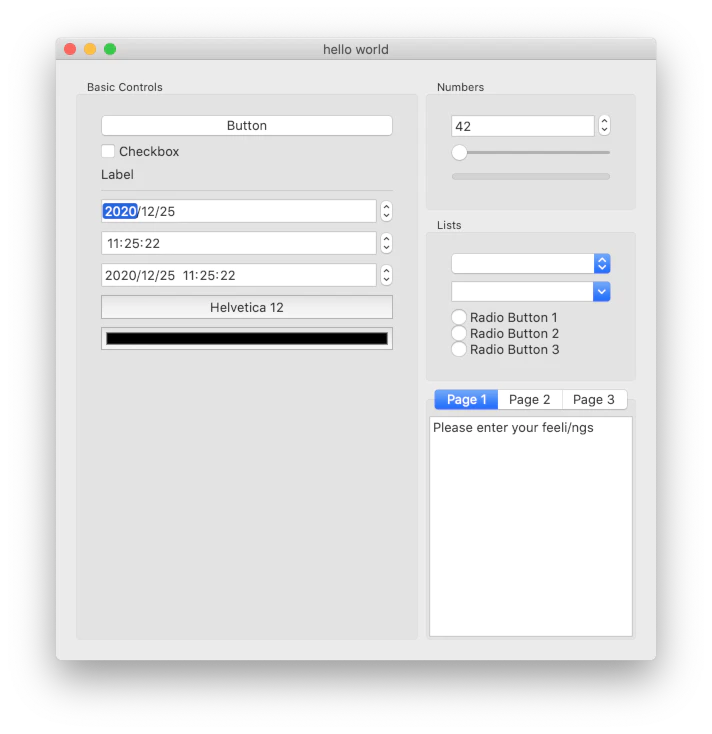LibUI
LibUI is a Ruby wrapper for libui and libui-ng.
:rocket: libui-ng - A cross-platform portable GUI library
:radio_button: libui - Original version by andlabs
Installation
gem install libui
- The gem package contains the official release of the libui shared library versions 4.1 for Windows, Mac, and Linux.
- Namely
libui.dll,libui.dylib, andlibui.so(only 1.8MB in total).
- Namely
- No dependency
- The libui gem uses the standard Ruby library Fiddle to call C functions.
| Windows | Mac | Linux |
|---|---|---|
 |
 |
 |
Note:
- If you are using the 32-bit (x86) version of Ruby, you need to download the 32-bit (x86) native dll. See Development.
- On Windows, libui may not work due to missing DLLs. In that case, you need to install Visual C++ Redistributable. See (#48)
- Raspberry Pi and other platform users will need to compile C libui. See Development.
Usage
require 'libui'
UI = LibUI
UI.init
main_window = UI.new_window('hello world', 200, 100, 1)
= UI.('Button')
UI.() do
UI.msg_box(main_window, 'Information', 'You clicked the button')
end
UI.window_on_closing(main_window) do
puts 'Bye Bye'
UI.control_destroy(main_window)
UI.quit
0
end
UI.window_set_child(main_window, )
UI.control_show(main_window)
UI.main
UI.quit
See examples directory.
General Rules
Compared to original libui written in C,
- The method names are snake_case.
- If the last argument is nil, it can be omitted.
- You can pass a block as a callback.
- The block will be converted to a Proc object and added to the last argument.
- Even in that case, it is possible to omit the last argument when nil.
You can use the documentation for libui's Go bindings as a reference.
DSLs for LibUI
LibUI is intentionally not object-oriented because it is a thin Ruby wrapper (binding) for the procedural C libui library, so it mirrors its API structure.
It is recommended that you build actual applications using a DSL for LibUI because DSLs enable writing object-oriented code the Ruby way (instead of procedural code the C way):
How to use fiddle pointers?
require 'libui'
UI = LibUI
UI.init
Convert a pointer to a string.
label = UI.new_label("Ruby")
p pointer = UI.label_text(label) # #<Fiddle::Pointer>
p pointer.to_s # Ruby
If you need to use C structs, you can do the following.
= UI.
# Allocate memory
font_descriptor = UI::FFI::FontDescriptor.malloc
font_descriptor.to_ptr.free = Fiddle::RUBY_FREE
# font_descriptor = UI::FFI::FontDescriptor.malloc(Fiddle::RUBY_FREE) # fiddle 1.0.1 or higher
UI.() do
UI.(, font_descriptor)
p family: font_descriptor.Family.to_s,
size: font_descriptor.Size,
weight: font_descriptor.Weight,
italic: font_descriptor.Italic,
stretch: font_descriptor.Stretch
end
- Callbacks
- In Ruby/Fiddle, a C callback function is written as an object of
Fiddle::Closure::BlockCallerorFiddle::Closure. In this case, you need to be careful about Ruby's garbage collection. If the function object is collected, memory will be freed and a segmentation violation will occur when the callback is invoked.
- In Ruby/Fiddle, a C callback function is written as an object of
# to a local variable to prevent it from being collected by GC.
handler.MouseEvent = (c1 = Fiddle::Closure::BlockCaller.new(0, [0]) {})
handler.MouseCrossed = (c2 = Fiddle::Closure::BlockCaller.new(0, [0]) {})
handler.DragBroken = (c3 = Fiddle::Closure::BlockCaller.new(0, [0]) {})
How to create an executable (.exe) on Windows
OCRA (One-Click Ruby Application) builds Windows executables from Ruby source code.
In order to build a exe with Ocra, include 3 DLLs from ruby_builtin_dlls folder:
ocra examples/control_gallery.rb ^
--dll ruby_builtin_dlls/libssp-0.dll ^
--dll ruby_builtin_dlls/libgmp-10.dll ^
--dll ruby_builtin_dlls/libffi-7.dll ^
--gem-all=fiddle ^
Add additional options below if necessary.
--window ^
--add-all-core ^
--chdir-first ^
--icon assets\app.ico ^
--verbose ^
--output out\gallery.exe
Development
LibUI is not object-oriented, but it provides high portability with a minimal implementation.
git clone https://github.com/kojix2/libui
cd libui
bundle install
bundle exec rake vendor:default # download shared libraries for all platforms
bundle exec rake test
You can use the following rake tasks to download the shared library required for your platform.
rake -T
rake vendor:kojix2:auto # Download kojix2 pre-build for your platform to vendor directory
rake vendor:kojix2:mac # Download kojix2 pre-build for Mac to vendor directory
rake vendor:kojix2:ubuntu_x64 # Download kojix2 pre-build for Ubuntu to vendor directory
rake vendor:kojix2:windows_x64 # Download kojix2 pre-build for Windows to vendor directory
rake vendor:kojix2:windows_x86 # Download kojix2 pre-build for Windows to vendor directory
rake vendor:libui-ng:build[hash] # Build libui-ng latest master [commit hash]
rake vendor:libui-ng:mac # Download latest dev build for Mac to vendor directory
rake vendor:libui-ng:ubuntu_x64 # Download latest dev build for Ubuntu to vendor directory
For example, If you are using a 32-bit (x86) version of Ruby on Windows, type vendor:kojix2:windows_x86.
Use C libui compiled from source code
You can compile C libui from source code on your platform and tell ruby LibUI where to find the shared libraries. Set environment variable LIBUIDIR to specify the path to the shared library. (See #46). This is especially useful on platforms where the LibUI gem does not provide shared library, such as the ARM architecture (used in devices like Raspberry Pi).
Another simple approach is to replace the shared libraries in the gem vendor directory with the ones you have compiled.
libui or libui-ng
- From version 0.1.X, we plan to support only libui-ng/libui-ng.
- Version 0.0.X only supports andlabs/libui.
Contributing
Would you like to add your commits to libui?
- Please feel free to send us your pull requests.
- Small corrections, such as typo fixes, are appreciated.
- Did you find any bugs? Enter in the issues section!
I have seen many OSS projects abandoned. The main reason is that no one has the right to commit to the original repository, except the founder. Do you need commit rights to my repository? Do you want to get admin rights and take over the project? If so, please feel free to contact me @kojix2.
Acknowledgement
This project is inspired by libui-ruby.
While libui-ruby uses Ruby-FFI, this gem uses Fiddle.
